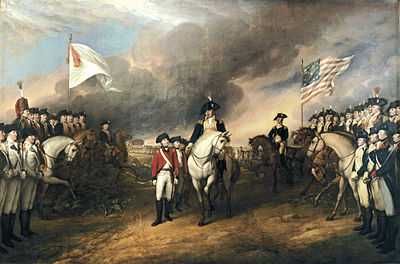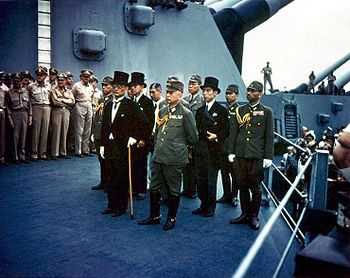Surrender (military)



by John Trumbull, depicting the British surrendering to French (left) and American (right) troops. Oil on canvas, 1820.


Surrender in military terms is the relinquishment of control over territory, combatants, fortifications, ships, or armament to another power. A surrender may be accomplished peacefully, without fighting; or it may be the result of defeat in battle. A sovereign state may surrender following defeat in a war, usually by signing a peace treaty or capitulation agreement. A battlefield surrender, either by individuals or when ordered by officers, will normally result in those surrendering becoming prisoners of war.
History
A white flag or handkerchief is often taken or intended as a signal of a desire to surrender, although in international law, (also can be a treaty) it simply represents a desire for a parley that may or may not result in a formal surrender. Normally, a surrender will involve the handing over of weapons; in European warfare of earlier centuries, the commanding officer of a surrendering force would specifically offer up his sword to the victorious commander. Individual combatants can indicate a surrender by discarding weapons and raising their hands empty and open above their heads; a surrendering tank commander should point the tank's turret away from opposing combatants. Flags and ensigns are hauled down or furled, and ships' colors are struck to signal a surrender.
When the parties agree to terms, the surrender may be conditional, i.e., if the surrendering party promises to submit only after the victor makes certain promises. Otherwise it is a surrender at discretion (unconditional surrender); the victor makes no promises of treatment other than those provided by the laws and customs of war – most of which are laid out in the Hague Convention of 1907 and the Geneva Conventions. Normally, a belligerent will only agree to surrender unconditionally if completely incapable of continuing hostilities.
The Third Geneva Convention states that prisoners of war should not be mistreated or abused. United States Army policy, for example, requires that surrendered persons should be secured and safeguarded while being evacuated from the battlefield. Similar regulations exist in most modern militaries.
False Surrender
False surrender is a type of perfidy in the context of war. It is a war crime under Protocol I of the Geneva Convention. False surrenders are usually used to draw the enemy out of cover so as to attack them off guard, although they may be used in larger operations such as during a siege. Accounts of false surrender can be found relatively frequently throughout history. One of the more infamous examples was the alleged false surrender of British troops at Kilmichael, during the Irish War of Independence.
See also
- Capitulation, an agreement in time of war for the surrender to a hostile armed force of a particular body of troops, a town or a territory.
- Debellatio occurs when a war ends because of the complete destruction of a belligerent state.
- No quarter occurs when a victor shows no clemency or mercy and refuses to spare the life of the vanquished when they surrender at discretion. Under the laws of war, "....it is especially forbidden....to declare that no quarter will be given".
- Strategic surrender
- Unconditional surrender is a surrender without conditions, except for those provided by international law.
References
![]() Media related to Surrendering at Wikimedia Commons
Media related to Surrendering at Wikimedia Commons